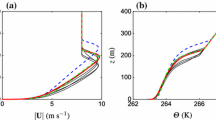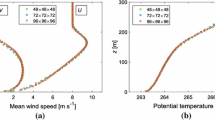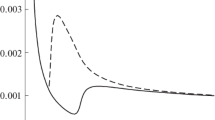Abstract
An improved first-order closure approximation is developed for the non-local ‘transilient turbulence’ parameterization. Instead of using Richardson numbers, this improved approach uses non-local approximations to the shear, buoyancy, storage, and dissipation terms of the turbulence kinetic energy equation to parameterize the turbulent mixing potential between every combination of grid points in a 1-D model of the atmosphere. The original (n 2 − n) degrees of freedom associated with the independent transilient matrix coefficients for a model of n grid points is thus reduced to four degrees of freedom associated with the four free parameters.
The resulting parameterization is applied to three consecutive case-study days of boundary-layer data acquired near the Cabauw tower in The Netherlands. The first day is used for sensitivity tests to select the best values of the four free parameters. The remaining two days, used as independent tests, demonstrate that realistic entraining mixed layers and nocturnal boundary layers form in the model without explicitly parameterizing such boundary layers. Simulations are also presented for two idealized cases: ‘dry’ stratocumulus-induced convection and a neutral boundary layer.
Similar content being viewed by others
References
André, J.-C., DeMoor, G., Lacarrère, P., Therry, G., and du Vachet, R.: 1978, ‘Modeling the 24-hour Evolution of the Mean and Turbulent Structures of the Planetary Boundary Layer’, J. Atmos. Sci. 35, 1861–1883.
Bhumralkar, C. M.: 1975, ‘A Survey of Parameterization Techniques for the Planetary Boundary Layer in Atmospheric Circulation Models’, ARPA Report R-1653-ARPA (order # 189-1), 84 pp.
Driedonks, A. G. M.: 1981: ‘Dynamics of the Well-Mixed Atmospheric Boundary Layer’, Doctoral Dissertation, Free University of Amsterdam, KNMI Scientific Report 81-2, KNMI, De Bill, The Netherlands, 189 pp.
Driedonks, A. G. M.: 1982, ‘Models and Observations of the Growth of the Atmospheric Boundary Layer’, Boundary-Layer Meteorol. 23, 283–306.
Driedonks, A. G. M. and Tennekes, H.: 1984, ‘Entrainment Effects in the Well-Mixed Atmospheric Boundary Layer’, Boundary-Layer Meteorol. 30, 75–105.
Driedonks, A. G. M., van Dop, H., and Kohsiek, W.: 1978, ‘Meteorological Observation on the 213 m Mast at Cabauw in the Netherlands, Preprints from the’ Fourth Symp. on Meteor. Obs. and Instr., Denver, U.S.A., Amer. Meteor. Soc., Boston, U.S.A., pp. 41–46.
Gaspar, Ph., Stull, R., and Boissier, Ch.: 1987, ‘Long-Term Simulation of the Upper Ocean Mixing Using Transilient Turbulence Theory’, International Liége Colloquium on Ocean Hydrodynamics, Belgium, 150 pp.
Loius, J. F.: 1979, ‘A Parametric Model of Vertical Eddy Fluxes in the Atmospheric’, Boundary-Layer Meteorol. 17, 187–202.
Mellor, G. L. and Yamada, T.: 1982, ‘Development of a Turbulence Closure Model for Geophysical Fluid Problems’, Rev. Geophys. Space Phys. 20, 851–875.
Nieuwstadt, F. T. M.: 1984, ‘Some Aspects of the Turbulent Stable Boundary Layer’, Boundary-Layer Meteorol. 30, 31–56.
Nieuwstadt, F. T. M. and Brost, R. A.: 1986, ‘The Decay of Convective Turbulence’, J. Atmos. Sci. 43, 532–546.
Stull, R. B.: 1976, ‘Mixed-Layer Depth Model Based on Turbulent Energetics’, J. Atmos. Sci. 33, 1268–1278.
Stull, R. B.: 1984, ‘Transilient Turbulence Theory. Part I: The Concept of Eddy Mixing Across Finite Distances’, J. Atmos. Sci. 41, 3351–3367.
Stull, R. B.: 1986, ‘Transilient Turbulence Theory. Part III: Bulk Dispersion Rate and Numerical Stability’, J. Atmos. Sci. 43, 50–57.
Stull, R. B.: 1987, ‘Transilient Turbulence Algorithms to Model Mixing Across Finite Distances’, Environ. Software 2, 4–12.
Stull, R. B. and Hasegawa, T.: 1984, ‘Transilient Turbulence Theory. Part II: Turbulent Adjustment’, J. Atmos. Sci. 41, 3368–3379.
Stull, R. B. and Kraus, E.: 1987, ‘atThe Transilient Model of the Upper Ocean’, J. Geophys. Res. Oceans (in press).
Wyngaard, J. C.: 1982, ‘Boundary Layer Modeling’, in F. T. M. Nieuwstadt and H. van Dop (eds.), Atmospheric Turbulence and Air Pollution Modelling, D. Reidel Publ. Co., Dordrecht, Holland, pp. 69–1061.
Wyngaard, J. C. and Brost, R. A.: 1984, ‘Top-Down and Bottom-Up Diffusion of a Scalar in the Convective Boundary Layer’, J. Atmos. Sci. 41, 102–112.
Zeman, O.: 1981, ‘Progress in the Modeling of Planetary Boundary Layers’, Ann. Rev. Fluid Mech. 13, 253–272.
Author information
Authors and Affiliations
Additional information
Work performed while a visiting scientist at the Royal Netherlands Meteorological Institute.
Rights and permissions
About this article
Cite this article
Stull, R.B., Driedonks, A.G.M. Applications of the transilient turbulence parameterization to atmospheric boundary-layer simulations. Boundary-Layer Meteorol 40, 209–239 (1987). https://doi.org/10.1007/BF00117449
Accepted:
Issue Date:
DOI: https://doi.org/10.1007/BF00117449




